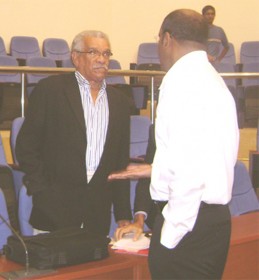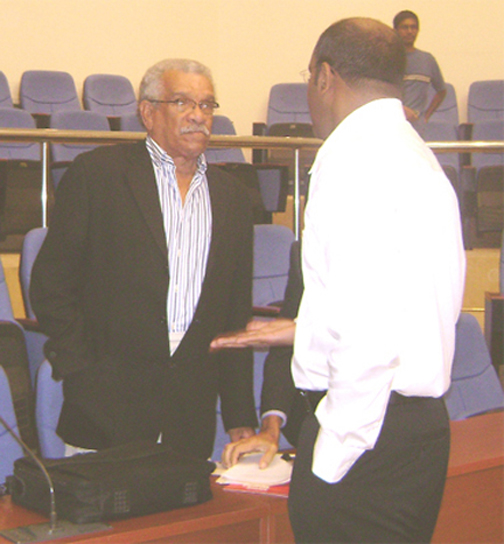During Carifesta X in Guyana in 2008, one of the usual features, the Carifesta Symposia, assumed greater prominence than in most of the previous regional festivals. At least, not since 1992 in Trinidad have these panels, through which the intellectual companions to the arts are discussed, occupied a place of such magnitude in the proceedings. Those held in Suriname in 2003 were more important than most of those that went before it, because it was there that the state of Carifesta since its beginnings was first seriously examined. But the series in 2008 coordinated by the University of Guyana for Carifesta X saw the Symposia take on significant proportions as one of the major events, with a five-part series – a Grand Opening Symposium and four others – running from Sunday to Friday.

Among the real issues taken on, which deepened the significance of the Symposia, was a panel on cultural industries. It was titled Are We There Yet? Refining and Defining Our Cultural Industries. Despite the impact of the Grand Opening which caught media attention because of the participation of both a Nobel Laureate and a Head of State, this panel was the most crucial because it most directly defined the whole series. It did what the Symposia wanted to do; namely, move beyond intellectual discourse by academics, which characterised those which had taken place in previous festivals, and get to the core of real problems in need of attention and solutions. It took on an issue relevant to the livelihood of large numbers of people across the Caribbean, tackling as it did, the state of regional cultural industries. Certainly, the Caribbean is still largely unaware that the livelihood of so many could depend on art.

‘Are we there yet?’ The title makes reference to two things: that the region is still in the process of “refining and defining” its cultural industries, and that we are not yet sure whether we have reached the point where we have satisfactorily recognised what our cultural industries are, and have reached a point where we comfortably accept them and accord them their place in the cultural and economic life of our societies. The idea of cultural industries is still fairly new to the Caribbean, despite the fact that it is an old phenomenon and that some of the industries are multi-million dollar earners. But the gap is wide between those and other smaller ones which are unrecognised and struggling to sustain themselves.
At the core of the problem is that Caribbean society is not yet accustomed to seeing art as an industry. West Indians have existed in the time warp of ‘art for art’s sake,’ in which the creation of art is its own reward; in which art is a pastime, not an occupation; it is entertainment, a gift; it is sublime and above money. Art is talent to be given freely and there is little recognition of it as an artistic product from which anyone can earn a living. Because of this the market is largely undeveloped, marketing is unsophisticated and inefficient, artists are hardly seen as worthy of their hire, and the society is still not ready to pay for it. The notion of copyright is hazy, intellectual property is a new concept to the wider population and piracy is the accepted norm.
The issues are that not everyone knows what cultural industries are. Everyone is aware of art, but not of the industries that have developed around art. In addition, some of the larger, more popular activities are very well known, and people participate in them very often without realising that they are cultural industries. It is not feasible to try to list them and one can only attempt an idea of what some of them are. To start with the huge ones, there is the music industry in which reggae, and now dancehall, have turned over billions of dollars. Then there are some elements of the entertainment industry which have many parts and facets, including the recording studios, musicians and technicians. But there are many other performers, designers and participants apart from those in music. There is carnival with the several enterprises involved in it which make money and employ, hire or pay people. It is known that the leading performers and artists earn a great deal of money; Bob Marley had become a millionaire.Within these industries are many other persons who work full time.
With heightened frequency since 2000, Caricom ministerial and technical meetings such as COHSOD dealing with matters of human and social development have been working out and defining cultural industries and workers in their attempts to form agreements about the free movement of persons in the performing arts. They have been involved in the problems of identification, definition and recognition of what the industries are and who the workers are within them.
The Caribbean film industry is one which should be large, but is still being defined and refined. Several feature films have been made including mega-hits like The Harder They Come or Cool Runnings. Many others have been made, but the Caribbean cinema and Caribbean movies are still a part of one of the cultural industries which provoke the question “are we there yet?” Despite the hectic activity over more than thirty years how sustainable, how reliable and how developed is it as an industry? Funding and financial backing for movies remain an issue, as is the market; despite the many artistic and popular successes is there a guaranteed paying audience to make it sustainable? Can it provide permanent employment?
What is more stable than the Caribbean cinema is the production of smaller films and videos and even more than those, the video industry which produces commercial rather than artistic work. Those activities outstrip the production of works such as Dance Hall Queen made more for the video/DVD market than for the cinema. There are film-makers with good reputations who are creative and who make films that fall in other categories. But the busier area of work is the videography for advertising, documentaries of various types and a wide range of other purposes, including the recording of private and personal events. But the making of videos and non-cinema, non-artistic films is a large and viable occupation. Apart from those are several others in the category of less recognized, less defined and well in need of refining in terms of their development, sustainability and general treatment. These include illustrators, graphic artists, makers of greeting cards, sculptors and landscape painters, craftsmen, some groups of artisans and a host of others.
These are the types who would more need attention largely because the sculptors and landscape painters, for example, are not recognized within the mainstream of artists. They would not exhibit in galleries, but sell their work on the streets or in craft shops, and are categorised as commercial artists. Among the many reasons these industries are under-developed is that the workers are individuals working on their own outside of the establishment. They have no representation and exist in a framework in which people do not generally recognise that they are part of cultural industries.
It is issues surrounding their very existence, their maintenance and support, their rights and their development that make it necessary for Caribbean societies to come to grips with their cultural industries. They are still in need of refining and redefining. We are not quite there yet.

